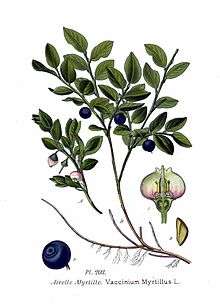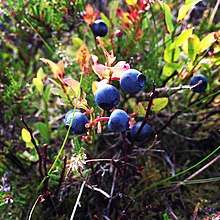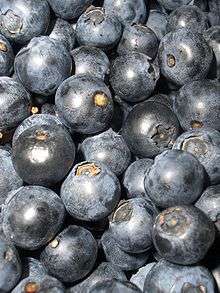Vaccinium myrtillus
Vaccinium myrtillus is a species of shrub with edible fruit of blue color, commonly called "bilberry", "wimberry", "whortleberry", or European blueberry.[3] It has much in common with the American blueberry (Vaccinium cyanococcus). It is more precisely called common bilberry or blue whortleberry, to distinguish it from other Vaccinium relatives. Regional names include blaeberry, urts or hurts (Cornwall & Devon ),[4] hurtleberry,[5] huckleberry, myrtleberry,[6] wimberry, whinberry, winberry,[7] blueberry,[8] and fraughan.[9] Chromosome count is 2n =24.[10]
| Vaccinium myrtillus | |
|---|---|
 | |
| 1891 illustration[1] | |
| Scientific classification | |
| Kingdom: | Plantae |
| Clade: | Tracheophytes |
| Clade: | Angiosperms |
| Clade: | Eudicots |
| Clade: | Asterids |
| Order: | Ericales |
| Family: | Ericaceae |
| Genus: | Vaccinium |
| Subgenus: | Vaccinium subg. Vaccinium |
| Section: | Vaccinium sect. Myrtillus |
| Species: | V. myrtillus |
| Binomial name | |
| Vaccinium myrtillus L. 1753 | |
| Synonyms[2] | |
| |
Range
Vaccinium myrtillus is found natively in Continental Northern Europe, the British Isles and Ireland, Iceland and across the Caucasus into northern Asia. It is a non-native introduced species in Western Canada and the Western United States.[11] It occurs in the wild on heathlands and acidic soils. Its berry has been long consumed in the Old World.[12] It is related to the widely cultivated North American blueberry.
Uses

Fruit
Vaccinium myrtillus has been used for nearly 1,000 years in traditional European medicine. Vaccinium myrtillus fruits have been used in traditional Austrian medicine internally (directly or as tea or liqueur) for treatment of disorders of the gastrointestinal tract and diabetes.[13] Herbal supplements of V. myrtillus (bilberry) on the market are used for cardiovascular conditions, diabetes, as vision aids, and to treat diarrhea and other conditions.[3] Researchers are interested in bilberry because of its high concentrations of anthocyanins, which may have various health benefits.[3] The United States' National Institutes of Health (NIH) cautions, "There’s not enough scientific evidence to support the use of bilberry for any health conditions."[3]
In cooking, the bilberry fruit is commonly used for the same purposes as the American blueberry, such as pies, cakes, jams, muffins, cookies, sauces, syrups, juices, and candies.[3]
Leaf
In traditional medicine, bilberry leaf is used for different conditions, including diarrhea, scurvy, infections, burns, and diabetes.[3]
Confusion between bilberries and American blueberries

Since many people refer to "blueberries" whether they mean the bilberry (European blueberry) Vaccinium myrtillus or the American blueberries, there is confusion about the two closely similar fruits. One can distinguish bilberries from their American counterpart by the following differences:
- bilberries have dark red, strongly fragrant flesh and red juice that turns blue in basic environments; blueberries have white or translucent, mildly fragrant flesh
- bilberries grow on low bushes with solitary fruits, and are found wild in heathland in the Northern Hemisphere; blueberries grow on large bushes with the fruit in bunches
- bilberries are usually harvested from wild plants, while blueberries are usually cultivated and are widely available commercially
- cultivated blueberries often come from hybrid cultivars, developed about 100 years ago by agricultural specialists, most prominently Elizabeth Coleman White, to meet growing consumer demand; the bushes grow taller and are easier to harvest
- bilberry fruit will stain hands, teeth and tongue deep blue or purple while eating (it was used as a dye for food and clothes),[14] while blueberries have flesh of a less intense color, and are thus less staining
- when cooked as a dessert, bilberries have a much stronger, more tart flavor and a rougher texture than blueberries
Adding to the confusion is the fact there are also wild American blueberry varieties, sold in stores mainly in the US and Canada. These are uncommon outside of North America. Even more confusion is due to the huckleberry name, which originates from English dialectal names 'hurtleberry' and 'whortleberry' for the bilberry. In the Scandinavian languages Vaccinium myrtillus is called blåbär (or blåbær), which literally means blueberry. Therefore many Scandinavians erroneously call bilberry blueberry when speaking English. This adds to the confusion.
See also
- Blaeberry River
- Mahonia aquifolium (Oregon grape)
- Myrtus
References
- illustration by Amédée Masclef, published in Atlas des plantes de France. 1891
- The Plant List, Vaccinium myrtillus L.
- "Bilberry : Science and Safety | NCCIH". Nccih.nih.gov. Retrieved 2018-03-19.
- Phillipps, K. C. (1993). A Glossary of the Cornish Dialect. Padstow: Tabb House. p. 57. ISBN 0907018912.
- "Vaccinium myrtillus". Germplasm Resources Information Network (GRIN). Agricultural Research Service (ARS), United States Department of Agriculture (USDA). Retrieved 12 December 2017. citing Wiersema, J. H. & B. León (1999), World economic plants: a standard reference, and Huxley, A., ed. (1992), The new Royal Horticultural Society dictionary of gardening
- "Bilberry, Blaeberry, Whortleberry, Whinberry, Windberry, Myrtle Berry, Vaccinium myrtillus". Wild Food UK. Retrieved 2020-07-31.
- Henley, Jon. Bilberries: the true taste of northern England, The Guardian, Monday 9 June 2008
- Grigson, Geoffrey (1975). The Englishman's Flora. Paladin. p. 281. ISBN 0586082093.
- "Fraughan is an anglicisation of the Irish word Fraochán (or heather fruit, as the plant is often found growing with heather)". téarma.ie.
- Nestby, Rolf; Percival, D.; Martinussen, Inger S.; Opstad, Nina; Rohloff, Jens (2017-08-08). "The European Blueberry ( Vaccinium myrtillus L . ) and the Potential for Cultivation . A Review". Semantic Scholar. Retrieved 2020-05-08.
- "Vaccinium myrtillus - L." Plants for a Future. Retrieved 27 April 2019.
- "The bilberry is an Old World equivalent of North American blueberry". Library.mothernature.com. Retrieved 2013-11-06.
- Vogl S, Picker P, Mihaly-Bison J, Fakhrudin N, Atanasov AG, Heiss EH, Wawrosch C, Reznicek G, Dirsch VM, Saukel J, Kopp B (2013-03-25). "Ethnopharmacological in vitro studies on Austria's folk medicine--an unexplored lore in vitro anti-inflammatory activities of 71 Austrian traditional herbal drugs". J Ethnopharmacol. 149: 750–71. doi:10.1016/j.jep.2013.06.007. PMC 3791396. PMID 23770053.
- Make Traditional Dyes - Bilberry Dye
Further reading
- Mykkänen, Otto T.; Mykkänen, Hannu; Kirjavainen, Pirkka V.; Huotari, Anne; Dunlop, Thomas W.; Herzig, Karl-Heinz (12 December 2014). "Wild Blueberries (Vaccinium myrtillus) Alleviate Inflammation and Hypertension Associated with Developing Obesity in Mice Fed with a High-Fat Diet". PLOS ONE. 9: 1. doi:10.1371/journal.pone.0114790. PMC 4264776. PMID 25501421. Retrieved 27 April 2015.
- Saponjac, Vesna Tumbas; Canadanovic-Brunet, Jasna; Cetkovic, Gordana (May 2015). "Dried bilberry (Vaccinium myrtillus L.) extract fractions as antioxidants and cancer cell growth inhibitors". LWT- Food Science and Technology. 61 (2): 615–621. doi:10.1016/j.lwt.2014.04.021.
External links
| Wikimedia Commons has media related to Vaccinium myrtillus. |